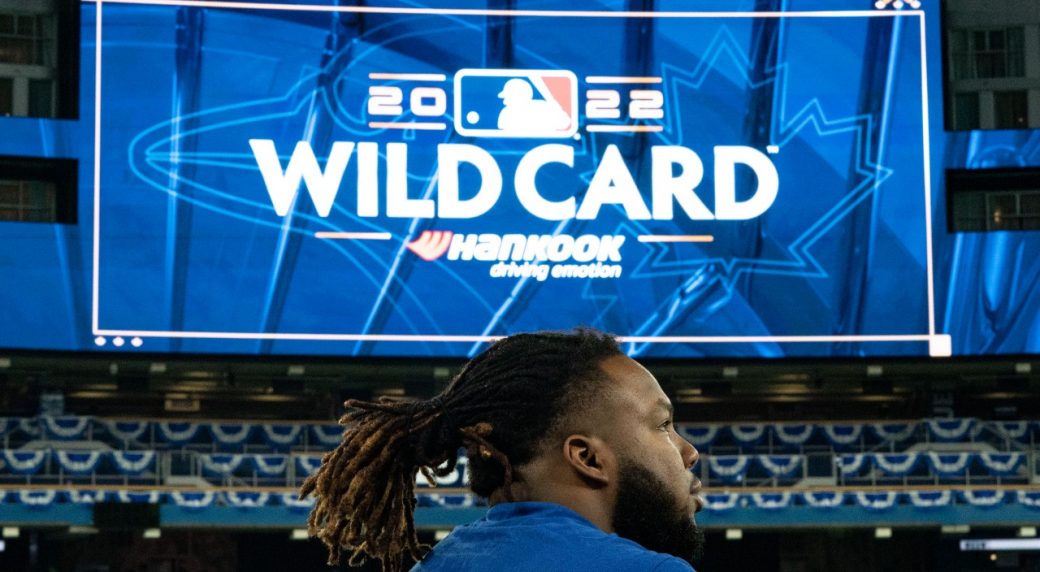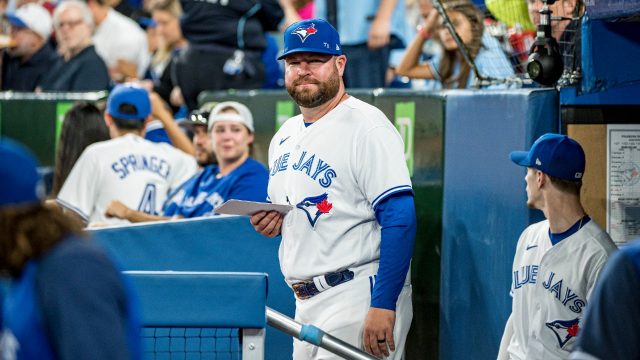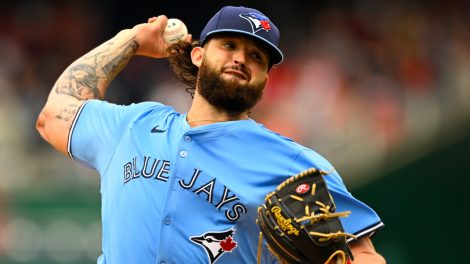TORONTO — The thing about rebuilds is that you can never really be sure how they’re going to play out. Ideally, a team that bottoms out turns into the Houston Astros, a perennial contender with one World Series ring, tainted as it may be, and counting. Less optimal is an outcome like that of the Chicago Cubs, who busted a century-long championship drought in 2016 only to quickly fall back into the abyss. Then there are teams who take forever to recover like the Seattle Mariners (first post-season since 2001 this year) and Philadelphia Phillies (first since 2011), or clubs that get stuck in the build cycle or never see a window through, like the Detroit Tigers, Arizona Diamondbacks and Colorado Rockies.
Which category the Toronto Blue Jays, who host their first post-season game since 2016 against the Mariners in a wild-card series that begins Friday afternoon, end up in is to be determined. Between the 1993 World Series and their return to the playoffs in 2015, they went through three teardowns, the last of which led to a brief window of opportunity from 2014-17 and consecutive trips to the American League Championship Series. A reset after a change in management followed and the club is now in a window of what it hopes is sustainable contention.
Already on the ledger is the playoff trip in the pandemic-shortened season of 2020 (a campaign that over a full 162 might have looked more like this year’s Baltimore Orioles performance) and last year’s one-game-short heartbreak. The platform is there for a deep run this fall and, managed smartly, for more in the years to come, which wasn’t necessarily the case last time.
“Back in 2015-16, it was an older group so you had a feeling that was potentially the last hurrah,” says pitching coach Pete Walker, one of the few holdovers remaining from those runs. “This one, it’s a different feeling because this group should be together for a while. We really feel like it’s the beginning of something as opposed to something you’re trying to grasp on to where you’ve got a great bunch of players, but older players that might be going in different directions. This, I don’t see why we wouldn’t be together for a while.”
The challenge, of course, is also in augmenting the group effectively, ensuring there’s a steady supply of young players to naturally turn over the roster and build sufficient organizational depth to withstand the inevitable attrition of the 162-game regular season.
Part of what truncated the last Blue Jays playoff core was that the gap between the aging players on the roster – at 29.5 in 2015 and 30.0 in 2016 the team’s position player group was the third-oldest in baseball – and the next wave of talent was too wide. While the likes of Vladimir Guerrero Jr., Bo Bichette, Cavan Biggio, Alejandro Kirk, Danny Jansen, Jordan Romano and Tim Mayza were all in the system back then, they didn’t start percolating up until 2018. The club needed help earlier and tried to bridge the gap with shorter-term free agents and low-risk trades during that time, but all that did was delay the inevitable.
Teardown trades added the likes of Teoscar Hernandez and Santiago Espinal along with assets that were used in later trades, such as Simeon Woods Richardson, who helped land Jose Berrios.
Another wave of young talent, led by Gabriel Moreno, Orelvis Martinez and the rapidly rising Ricky Tiedemann, is coming and can be worked in based on need in the coming years, as opposed to being thrown to the wolves the way the current group largely was.
“With how these past four years have been, people think that we have more experience than we do,” says Bichette, whose strong finish to the season helped carry the Blue Jays to the top wild-card spot. “I think most of us are in our second year. You can look at Baseball Reference and it will say it’s our fourth, but I don’t think that’s true. We’ve been through one season of ups and downs and we’re going through another and that’s part of the learning experience. When you’re on a good team, people are watching and you’re growing up in front of everybody.”
That’s come with its own set of challenges, although Bichette is quick to point out that “we’re blessed to have that opportunity — there’s no other way I would want it” — and adds that “it brings us closer together too, something that’s fun to go through.”
It’s something that bodes well for the Blue Jays’ chances of making October baseball a habit, as there’s still lots of upside on the roster. Guerrero and Kirk are both just 23, Bichette and Manoah are 24, Jansen and Biggio are 27, Berrios and Lourdes Gurriel Jr., are 28. Moreno touched the big-leagues at 22, while Martinez is 20 and hit 30 homers at double-A where he’s nearly four years below the level’s average age.
Another important development for the Blue Jays is that they’ve finally developed real depth on the big-league roster. In years past the September injuries to Gurriel and Espinal would have been daggers, but they’ve hardly missed a beat and have remained in the enviable position of having more players deserving of at-bats than at-bats to give.
“We do feel like it’s a healthy 40-man roster and our system is still in fine shape,” says GM Ross Atkins. “But creating a stronger organization from spots 33-40 on your roster is a big opportunity. Across the game, the teams that are able to have the strongest 40-man end up being the teams that are year in and year out contending and teams that fans can rely on to be there at the end of the season. There’s opportunity for us there too, whether it’s amateur acquisitions, or development of players just getting better. I feel like one of the areas we’ve improved the most over the last several years is in the player-development category, just having better processes, better systems and better resources, obviously with the Dunedin facility and being able to lean into that. That’s a huge area of focus for us.”
Those are the unsexy areas where the Blue Jays must close the gap on organizations like the Tampa Bay Rays, Los Angeles Dodgers, Astros, St. Louis Cardinals and Cleveland Guardians, who perennially churn out new talent while making clever adds with players who can either hit the ground running or are in need of some adjustments. Consider that in 2015, the Blue Jays employed only two analysts, compared to 16 now, all working on ways to apply reams of data more effectively.
One manifestation of that department’s growth is the Blue Jays’ dramatic increase in defensive shifts, going from just 25 per cent of plate appearances in 2021, a mark that left them 24th of 30, to 50.3 per cent, the third-highest total in majors, a smidge behind the Dodgers and Astros.
To make that work requires organizational cohesiveness between analysts, pro scouts, coaching staff and players and while Atkins says the way “we’re connecting one department to the next is in a very, very good place,” ideally, “I would like them to be more advanced.”
“I don’t think there is a Golden Goose or Silver Bullet (to compete sustainably),” says Atkins. “It’s constantly thinking about the six departments under the Major League Baseball construct – the major league team, player development, performance, amateur scouting, international scouting and professional scouting – and finding opportunities within them to push your organization forward. And if you’re not strong in one of those or in two of those, you’re probably going to get exposed at some point.”
An example of that came in the summer of 2017, and while there are those adamant the Blue Jays’ tepid approach to free agency and player acquisitions the previous winter frittered away another potential playoff run, they simply didn’t have enough underpinning in place. It was after that year that the Blue Jays should have started the teardown, rather than dragging it out over low-percentile hopes for contention in 2018, leaving the heavy lifting of both subtraction trades and the integration of youth for a 95-loss 2019.
“A lot of guys debuted and obviously it was a tough one,” said Jansen who, along with fellow 2013 draftee Mayza, is the player with the longest organizational tenure. “But as everybody was getting their feet wet, you could see the young talent. Bo, Vladdy, Gurriel, some of the pitchers, it was just like, well, there’s a core right there. And then you start adding some pieces along the way and here we are.”
Pivotal in that regard was the $80-million, four-year deal for Hyun Jin Ryu ahead of the 2020 season, a signing that demonstrated front-office commitment to the clubhouse and created some legitimacy for the Blue Jays in the market. The $150-million, six-year deal for George Springer came the next year, followed by the acquisition of and $131-million, seven-year extension for Berrios and the signing of Kevin Gausman for $110 million over five years.
“It’s exactly what they said. It’s exactly what was hoped,” Springer says of how closely his time with the Blue Jays has aligned with the vision marketed to him. “Exactly what was essentially promised, which was that there is a core here that has the talent to do it, and we want to surround them with anybody that we can to ultimately get to where our goal is, to win in the post-season and bring back a championship here. It’s been everything I could ever ask for.”
The next step for the Blue Jays is to deliver on their promise in the post-season and then stay there in the years to come. Last year’s gutting final-day miss was a talking point for the club all season and Bichette says that, “in a way, we kind of have been waiting for the playoffs all year.”
“That’s probably been part of our ups and downs,” he adds, “not being in the moment all the time, just waiting for this opportunity because of how close it was last year. I don’t know if it shaped us, but definitely didn’t want to feel like that again.”
The same goes for the entire organization after enduring the pain of the last rebuild. Top prospects don’t always hit but Guerrero and Bichette have indeed become cornerstones. Not all young players meet their projections, but many have or are on their way. The critical mass of talent necessary for success doesn’t always come together. For the Blue Jays, it seems that it did, but where they go from here will be the ultimate arbiter.
“It’s hard to predict,” Mayza replies when asked if he saw this coming back in 2019. “You knew the hype surrounding the prospects that were coming in and how good they were. I’d never played with them prior to getting here and even then, it was only a few months that I was able to play with them. But you definitely saw the potential. Coming back in ’21, seeing it come together and guys getting their comfort level, now it wasn’t just them getting their feet wet, they were performing at a high level. When the hype is there, I don’t know if you can predict how it’s going to translate, but it’s definitely translated for those guys and it’s been super-exciting to watch them grow and see what they’re living up to.”












